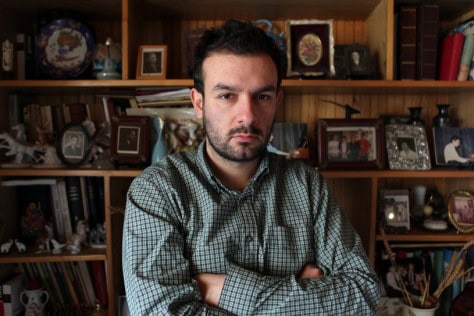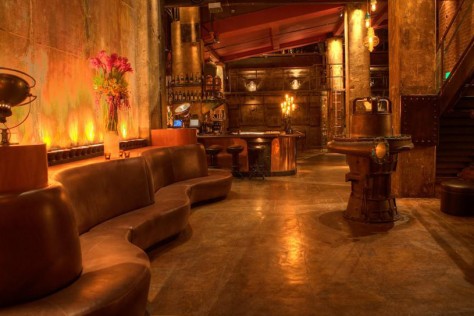You dropped out of high school at 15, and then got degrees from Art Center and Cranbrook in 2004 and 2006 respectively. What were you doing during that decade-plus time period between high school and university?
I dropped out of high school on the second day. I got my GED that freshman year and decided to study art in college. I did that for a year in Seattle, then got a scholarship and transferred to a school in New York (studied painting at Pratt). So I was living in New York and I got all strung-out. That’s where things started getting crazy; things were crazy before that but they really got crazy over there. I quit Pratt about a year after I started and the drugs ended up taking up the rest of the decade.
So what was the impetus to going to art school?
Initially when I dropped out of high school, I was on the road to becoming a painter. I was into De Kooning, abstract expressionism and modernist stuff. I was doing quirky landscapes and flower paintings (laughs). I’d had a lot of shows at churches, community colleges and malls. But then I got into drugs and I just put it down; I just didn’t chase after it like I had initially.
Eventually I started doing graphic design to make some money. But after a few years I got disillusioned with it – it seemed boring. So I went to under grad and then grad school, both for design. But Cranbrook was really more fine-art oriented. I made a lot of crazy stuff, installations and things like that. You know, your life goes one way and then another way…(laughs).
Do you see painting as work? Would you like to just live off your painting?
I’d do it. Hopefully someday that will happen. It’s all about how excessive you are. I’m pretty excessive. I need cash (laughs). If I lived in a little shithole… I mean I’ve done it for a long time; I lived with no overhead. If you do that, you don’t need much money coming in. You could probably get by doing just art.
So is working at [Shepard Fairey’s] Studio Number One just a gig to pay the bills, or are you passionate about design too?
I still like design too. I enjoy just making…and solving problems in the design sense, while also having my own voice in the art world. It’s nice to be able to make stuff and not have it be personal…like it’s just commercial work. At the same time, graphic design and art are not necessarily that different from each other. People like to label things, but I think there’s a bridge. Like the Dada stuff, which was very aesthetically design-ey, but it was fine art. So there’s a bridge between the two.
With design I try to put myself where I want to be. Like, I designed Shepard’s book, and that started from nothing. I just wanted to be doing work with other artists. I designed a book for Harmony Korine and Ari Marcopoulos. I also sometimes work with Aaron Rose. I try to get the design to merge into the art world.
Well, in your painting, you portray these scenes of chaos and mayhem, but in a manner that is highly organized and meticulously executed – your work is clearly “designed.” It’s not surprising that you are also a graphic designer.
In my paintings, I like working with elements that are common to both disciplines: compositional balance, kinetic movement and a basic color palette. Aesthetically I definitely carry over aspects from my design background. Actually, what I’m doing in my paintings today was initiated from a design project. After grad school, it wasn’t my ambition to go out and do art shows. I was working with Marsea [Goldberg] from New Image [Art Gallery] on a catalog for the Faile, Swoon, Dave Ellis show. She came to my house and saw this set of paintings I had done at Cranbrook and she asked me to put them in her gallery for an upcoming show. And from there Jeffery Deitch (and Kathy Grayson maybe?) bought the paintings. Then I was in his show, Mail Order Monsters in New York two years ago. So it was just this weird series of events that came together. I mean, I guess I did have ambitions to be an artist but I wasn’t out there sending slides to galleries.
When we first spoke, you said you didn’t want to show your work in progress – that you didn’t feel you had a “painterly process.” Do you feel that there is some accepted process that artists must follow to be considered valid painters?
I feel that people have an idea of craft, especially for painters. It’s the whole Jackson Pollock-ey, romantic, thing. And I don’t feel like I fit into that kind of mold. Like, I’m not out drawing on subway trains and shit. I used to be all into making a mess and working on like 20 different paintings at one time, and slopping color around, but now I’m more reserved. My style has just turned into what it is. Right now it’s very tight. It’s not loose like that. I just feel that this style and my process to achieve it doesn’t really fit that romantic notion people have of “painters.”
Your work kind of reminds me of Henry Darger; not in style, but in subject matter – these scenes of chaotic violence. Why this choice of subject?
A psychiatrist once bought one of my paintings, and he said I must be mad at my mother (laughs). Maybe, I don’t know. I’d say that part of what I’m painting are things that I feel like I’ve experienced – when I was at the low points in my life; when I was living on the streets, and a junkie…this world of turmoil and aggression and dualism. Where there’re rights and wrongs, and men, and women, and criminals, and normal people. I’m just interested in this high drama. Depicting this passionate event. I see violence and drugs and sex as those passionate, climaxes of the plot. With the color and energy within these paintings, I’m trying to create this world where everything is about to fall apart at the seams – where there’s so much intensity and deviance that there’s no room for anything else in a way; it’s just this image of chaos. That was what was interesting to me. I tend to like stories like that, films like that. This is a world that is pushed to the limits, but at the same time, I feel like I’m painting a reality. Like you see other painters using symbolism, but I try to stay away from that and paint a reality, but a chaotic, brutal reality.
Do you consider the viewer and what they will think when you create your work?
I don’t feel that as an artist, you should be an ambassador for what the world thinks you should say. Or create work that doesn’t push boundaries, or challenge. I like to do stuff that people aren’t necessarily going to like. I’d like to make something that people hate, but have to like at the same time. Even though I say that, it does bum me out when people walk out of the show, though (laughs)…especially when it’s your wife’s parent’s friends (laughs).
What is coming up?
• Now: Octo Pusses at New Image Art in LA until May 28th, 2009
• The Alice Gallery in Brussels in September 2009
• Flo Zavala from Studio Number One and I are going to be speaking at a conference in Mexico when I get back from Brussels: Esquina Norte Design Conference in TJ.
And a few other things for next year. There are a lot of opportunities right now, but I’m trying to chill out and be able to make new stuff. It takes me a while to paint stuff and if you get too booked up, it’s hard to get good quality work out. I want to step back and think things through.
 Q&A with Larry Gus
Q&A with Larry Gus We Own the Night: The Edison
We Own the Night: The Edison
No Comments